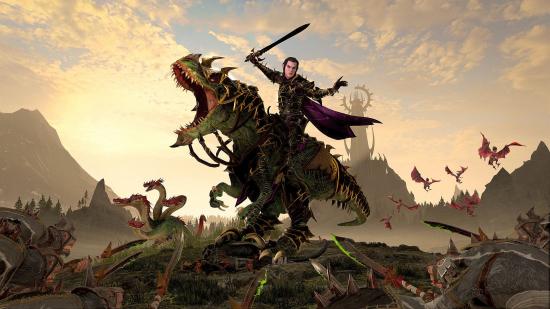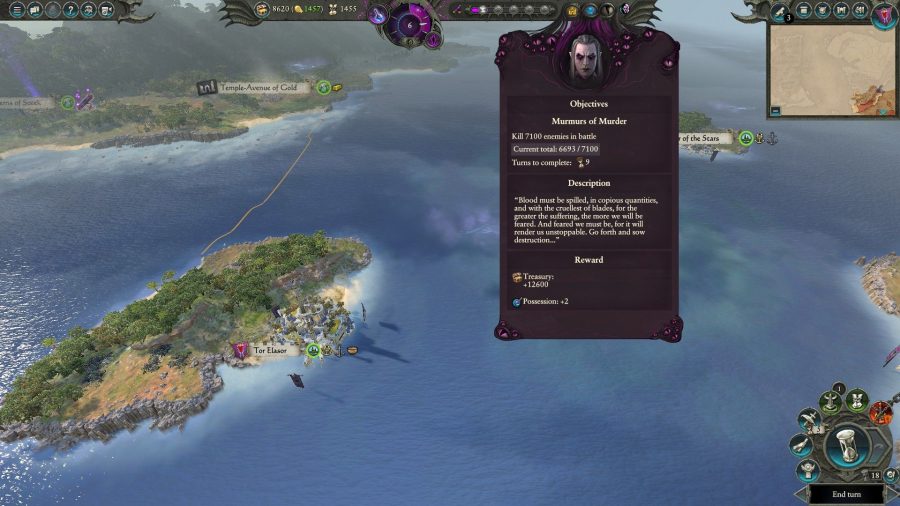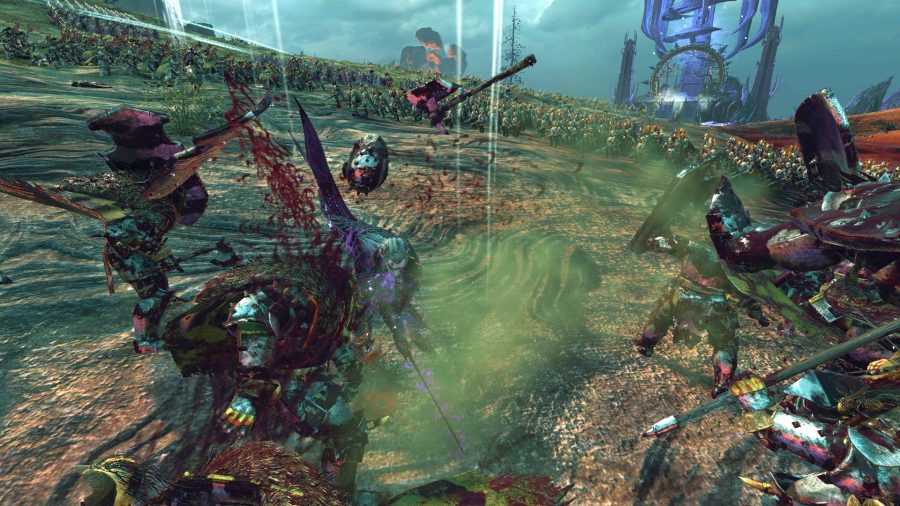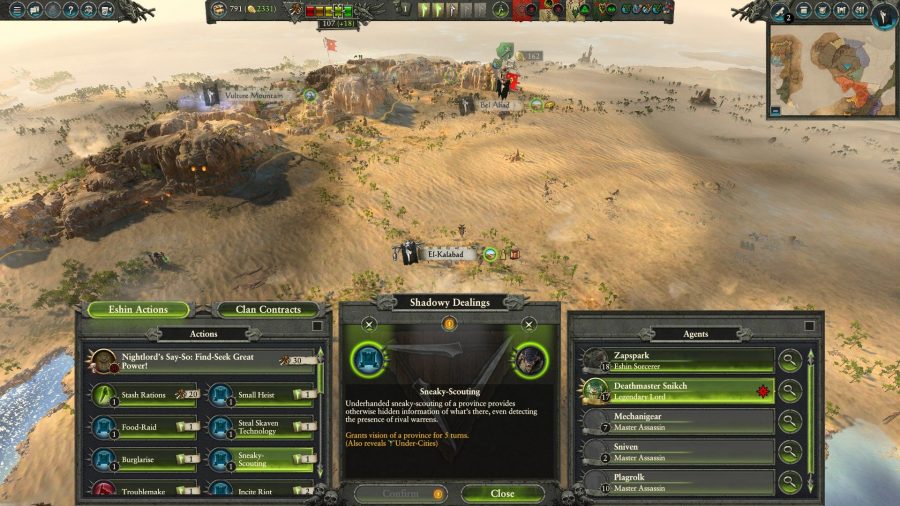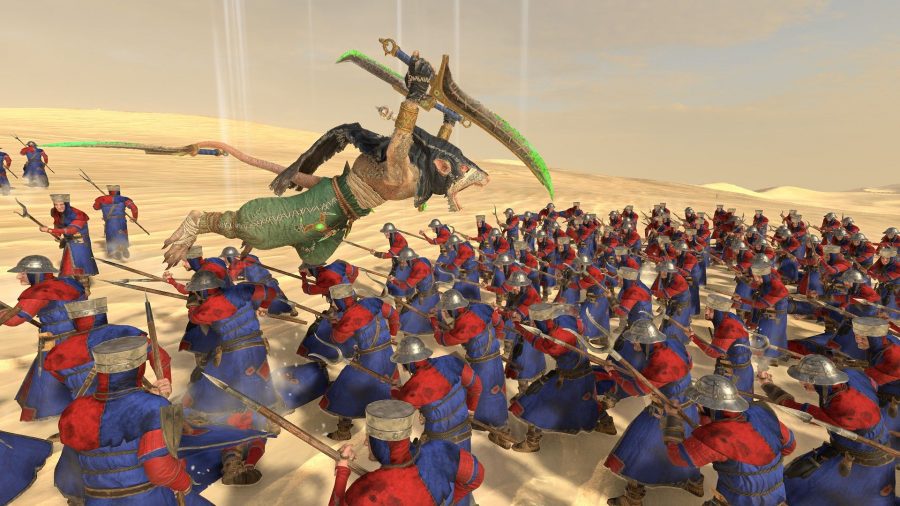Our Verdict
Is Malus Darkblade done justice? As a character, yes. But while his campaign is decent, Snikch’s is one of the weaker we've seen in these Lord packs, lacking some of CA's usual focus in mechanics and theme.
Few people were expecting the character combination in this Total War: Warhammer II Lord pack. Malus Darkblade, the daemon-haunted Druchii, is much beloved for his series of Black Library novels, but his opponent is a stranger choice. Deathmaster Snikch is a lesser known quantity, and as an assassin, is not supposed to be a leader. He works alone, and generally keeps his shadowy dealings to himself.
But maybe that’s why he’s a good choice? The chief assassin of Clan Eshin is known for his tendency to appear at random — the great fire of Lothern, bombing the Imperial navy, and assassinating pretty much anyone from wizards to Dwarf High Kings — all before fading back into the darkness. He is answerable only to the Nightlord, so when he’s told to get to the Southlands to find a mysterious source of power, Snikch sets about tracking it down.
This power is the Slaaneshi daemon Tz’arkan, Drinker of Worlds, who is trapped in a constant battle for control over the body of his host, Malus Darkblade. Malus himself has been sent to the Southlands to find Scrolls of Hekarti by the Witch King Malekith, who offers in exchange the recipe for an elixir which can finally subdue the daemon.
This conflict between Malus and Tz’arkan is represented by Possession, a mechanic which reflects the duality at the heart of his character. When Possession is low, Malus will be a better lord, granting buffs on the campaign map. But when Possession is high, he can transform into Tz’arkan on the battlefield, gaining a hefty stat-line, explosive magic, and a snazzy pink aura.

The catch is that when Possession is maxed out your armies won’t replenish, meaning you can’t let Tz’arkan run amok too long without severe repercussions. Similarly to Crone Hellebron’s Death Night with its increasing slave cost, Malus’s elixir reduces Possession, but costs more each time it’s used. This is further complicated by the strain of a dual start position in both Hag Graef and the Southlands, and that for every shipment of scrolls, the Skaven will do their best to kill-kill you.
It’s a decent campaign, giving Malus his own spin on gathering ritual currency, a unique mechanic, and the Whispers of Tz’arkan – special side objectives which grant rewards. It’s not perfect, though. It’d be nice if Possession cribbed another idea from Death Night, where capturing Quintex or the Gaean Vale would slow Hellebron’s degradation, giving you some long-term control. With Malus, scroll shipments don’t do anything to make Possession easier to bear, and it’s only at the very end of the campaign that you get elixir for free, by which point you’ve won (or lost) anyway.
As always it’s nice to see the digital army brought up to speed with its tabletop roster, especially when it means the addition of the Medusa, for which Dark Elf players who knew of its existence have been waiting for over two years. Warhammer’s interpretation of the terrifying monster of myth is superbly realised and doesn’t screw around – her deadly gaze turns enemy troops not to stone but explosions of gore. Other new arrivals include Scourgerunner chariots, which are absurdly fast and specialised against monsters, the High Beastmaster Lord, and Masters, which are basically the Dark Elf equivalent of High Elf nobles.
Thematically the new units give off a monster-hunting vibe which would have felt more at home in a Clar Karond Lord pack, but it’s not like CA had much choice as these are the last remaining omissions from the Dark Elf army book. However, Malus as a character is fantastic. Though he’ll never be my homeboy Fellheart, he encapsulates the vanity and cruelty of the Dark Elves in a way no other lord does, and his back-and-forth trash talking with Tz’arkan on the campaign map is a wonderful touch of flavour.
Deathmaster Snikch and Clan Eshin have the opposite problem — fantastic units, but a grindy campaign. Shadowy Dealings and Clan Contracts are Snikch’s mechanics, reflecting Eshin’s position in the Skaven Under-Empire as agents for hire. You can instigate a variety of actions against both settlements and armies, from theft, to sabotage, to assassination. You just select an agent, a target, and the action is carried out with a 100% success rate. This uses the new Eshin’s Scheme resource, which gradually replenishes up to a cap of five, which is the price of the highest actions, such as burning down cities or destroying Black Arks.
Clan Contracts work in a similar way. They don’t cost Schemes, but depending on who you choose to work for, favour with the four Great Clans will change, granting decreased recruitment costs for clan-specific units or very minor campaign debuffs.
While this does reflect Eshin’s extensive network of agents, it comes off pretty underwhelming in practice. Clan Contracts can be easily ignored, because they don’t give you item rewards, and you don’t need them to get non-Eshin units. Three of these instantaneous actions, undertaken by Snikch at levels five, 15 and 30, are basically his entire campaign. After doing them, he also disappears for a few turns, meaning the ensuing battle generally doesn’t even involve him.
Eshin are my favourite clan: ninja rats who are so badass that every other clan lives in fear of them. Turning that idea into clicking a couple of buttons in a list can’t help but feel reductive. Alith Anar had a far better assassination mechanic with actual campaign Lords to kill, and using the Empire’s new mechanic of teleporting single-turn battles, Eshin’s status as master assassins could’ve been depicted far more inventively. It definitely feels like Malus is the star of the show here, and got most of CA’s attention.
It’s a shame Eshin’s campaign isn’t great, because the new Skaven toys are a lot of fun. The combat animations for Deathmaster Snikch and the Master Assassin left me open-mouthed on more than one occasion, and the new Lore of Stealth magic feels perfect for a faction of sneaky rats. Eshin’s playstyle is about crowd control, making space and taking advantage of it, a tactic which even the non-Eshin units play into.
Warpstone Grinders can stop units in their tracks with a special ability, Poisoned Wind Mortars can devastate and slow infantry, and the Lore of Stealth has a spell entirely based around disrupting formations. The speed of Eshin as a faction, and their ability to stalk, makes it easy for them to take advantage of these disruptions before disappearing again. Though Snikch has low health and won’t outrun cavalry, he hits like a truck, with the armour penetration of his warpstone-coated weeping blades making him a veritable can opener. His speed can also be improved through campaign buffs — with Verminous Valour, a Banner of Swiftness, a Potion of Speed, and Slippery, I got him to 104, which is about as fast as Tyrion’s horse Malhandir. Now that’s a scary thought.
For $8.99 (£6.99) The Shadow and The Blade is decent value, offering plenty of play, some exciting new units, and an interpretation of Malus Darkblade that might actually match the hype. Both Tz’arkan and Deathmaster Snikch are terrors on the battlefield — Snikch especially has some of the best Lord animations I’ve seen in the entirety of Total: War Warhammer. But it’s not quite up to previous Lord packs like The Hunter and The Beast, with neither Lord’s campaign displaying the levels of storytelling and innovation of which CA has shown itself capable.
